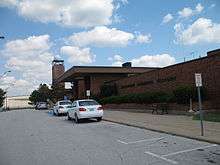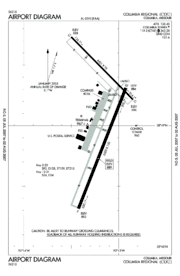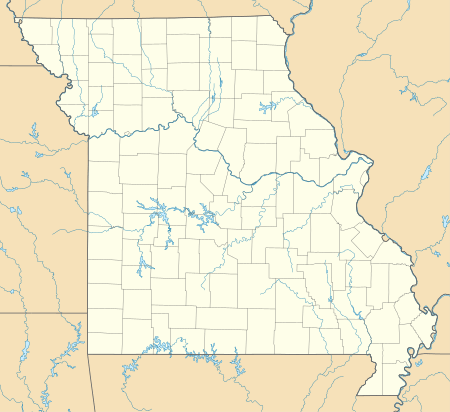Columbia Regional Airport
Columbia Regional Airport (IATA: COU, ICAO: KCOU)[2] is a commercial passenger airport serving Columbia, Missouri. Located about 12 miles southeast of Columbia in Boone County, Missouri, it is the only commercial airport in Mid-Missouri and also serves the state capital of Jefferson City.[1] As of 2019 commercial passenger service is provided by United Airlines and American Airlines. The airport opened in 1968, replacing the Columbia Municipal Airport off of I-70. It is frequently used for charter flights by college athletic teams visiting the University of Missouri and for MU team flights. Airport officials have plan to extend the 6,500 foot runway and build a new terminal. The runway will be extended first, with the terminal reconstruction two years later. The National Plan of Integrated Airport Systems for 2011–2015 categorized the airport as a primary commercial service airport.[3] Federal Aviation Administration records say the airport had 12,719 passenger boardings (enplanements) in calendar year 2008,[4] 26,842 in 2009 and 38,293 in 2010.[5] Scheduled passenger service was subsidized by the U.S. Department of Transportation via the Essential Air Service program until 2010, when Pinnacle Airlines dba Delta Connection began providing subsidy-free service.
Columbia Regional Airport | |||||||||||||||
|---|---|---|---|---|---|---|---|---|---|---|---|---|---|---|---|
 Airport entrance, September 2007 | |||||||||||||||
| Summary | |||||||||||||||
| Airport type | Public | ||||||||||||||
| Owner | City of Columbia | ||||||||||||||
| Serves | Mid Missouri (Columbia / Jefferson City) | ||||||||||||||
| Location | Boone County, Missouri, U.S. | ||||||||||||||
| Elevation AMSL | 889 ft / 271 m | ||||||||||||||
| Coordinates | 38°49′05″N 092°13′11″W | ||||||||||||||
| Website | http://www.flycou.com | ||||||||||||||
| Maps | |||||||||||||||
 FAA airport diagram | |||||||||||||||
 COU  COU | |||||||||||||||
| Runways | |||||||||||||||
| |||||||||||||||
| Statistics (2010) | |||||||||||||||
| |||||||||||||||
History
Until 2001 Trans World Express (Trans States Airlines) Jetstream 41s flew to St. Louis. After Trans World merged with American, American Connection (Trans States Airlines) Jetstream 41s flew to St. Louis until 2006. US Airways Express (Air Midwest) Beechcraft 1900s replaced American Connection, flying to Kansas City and St. Louis. Service to St. Louis was later dropped in favor of additional frequencies to Kansas City.
In 2008 Northwest Airlink (Mesaba Airlines) replaced US Airways Express, flying Saab 340s to Memphis. Later that year Northwest Airlines merged with Delta Air Lines. Delta Connection switched service from Mesaba Airlines to Pinnacle Airlines CRJ-200s in 2010. In June 2012 ExpressJet Airlines replaced Pinnacle Airlines as the Delta Connection carrier at Columbia and service to Atlanta began; in October 2012 service to Memphis was dropped. ExpressJet CRJ-200s flew to Atlanta and Memphis. Delta pulled out of Columbia Regional Airport on February 13, 2013.
In August 2012 Frontier Airlines announced plans for twice weekly flights from Columbia to Orlando.[6] In November 2012, Frontier started twice weekly flights to Orlando using Airbus A319 aircraft. Frontier ended service to Orlando on May 13, 2013.[7]
On October 22, 2012, it was announced by then-Columbia mayor Bob McDavid that American Airlines and the City of Columbia reached an agreement that was approved by the Columbia City Council for air service from Columbia to Chicago O'Hare and Dallas/Fort Worth and service to those two cities began in February 2013.[8]
The 2013 Federal sequester resulted in a planned closure of the airport's contract control tower. [9][10] The plan was postponed and later canceled.[11]
On February 27, 2017, Columbia and United Airlines officials announced that starting August 1, 2017, there would be one daily flight to Denver and two daily flights to Chicago O'Hare.[12] The new service lines added an additional 150 seats per day for a total 417 seats per day from Columbia. In April 2019, United Airlines added an additional flight to and from Chicago O'Hare for a total of 3 flights each direction. American Airlines followed suit adding two additional flights to Chicago-O'Hare for a total of 4 in each direction. In total, COU now has seven flights a day to and from Chicago-O'Hare (ORD), three a day to and from Dallas-Fort Worth (DFW), and one a day to and from Denver (DEN). All are operated on 50-76 seat regional jets.
On April 18, 2019, at a coffee round-table discussing the new terminal master plan, future destinations, and parking at the airport, it was revealed the airport hopes to add an additional 200 parking spots as well as have a design for the new terminal by the end of the year. Passengers expressed interest in adding Atlanta, Charlotte, and Las Vegas to the airport's growing list of destinations. As for the new terminal, preliminary sketches uploaded to the airport's website call for adding two more gates (for a total of four) with jet bridges built just to the south of the existing terminal. The new terminal is slated to begin construction in 2020 or 2021 with the grand opening in 2022.[13]
Facilities
The airport covers 1,538 acres (622 ha) at an elevation of 889 feet (271 m). It has two runways: 2/20 is 6,501 by 150 feet (1,982 x 46 m) concrete; 13/31 is 5,500 by 100 feet (1,341 x 23 m) asphalt.[1]
In 2010 the airport had 25,717 aircraft operations, average 70 per day: 79% general aviation, 10% military, 9% airline, and 2% air taxi. 41 aircraft were then based at the airport: 44% single-engine, 24% multi-engine, 27% jet, and 5% helicopter.[1]
In calendar year 2017, the airport had 88,650 enplanements, a 36.36% increase from 65,014 in 2016 and ranked as #243 out of 555 on the list of FAA airports with the most enplanements. [14]
Airlines and destinations
Passenger
| Airlines | Destinations |
|---|---|
| American Eagle | Chicago–O'Hare, Dallas/Fort Worth |
| United Express | Chicago–O'Hare, Denver |
Destinations map
| Destinations map |
|---|
All destinations from Columbia Regional Airport. |
Accidents and incidents
- On January 11, 2019, American Eagle Flight 5766, en route from Dallas-Fort Worth, slid off the runway after landing in icy and snowy conditions. The Bombardier CRJ-900, operated by Mesa Airlines, was the first flight to attempt to land at the airport after the ground crew cleared the runway of ice and snow. Reports state the runway was still very slick with ice.[15]
References
- FAA Airport Master Record for COU (Form 5010 PDF). Federal Aviation Administration. effective April 5, 2012.
- "IATA Airport Code Search (COU: Columbia Regional)". International Air Transport Association. Retrieved July 18, 2013.
-
"2011–2015 NPIAS Report, Appendix A" (PDF). National Plan of Integrated Airport Systems. Federal Aviation Administration. October 4, 2010. Archived from the original (PDF, 2.03 MB) on 2012-09-27. External link in
|work=(help) -
"Enplanements for CY 2008" (PDF, 1.0 MB). CY 2008 Passenger Boarding and All-Cargo Data. Federal Aviation Administration. December 18, 2009. External link in
|work=(help) -
"Enplanements for CY 2010" (PDF, 189 KB). CY 2010 Passenger Boarding and All-Cargo Data. Federal Aviation Administration. October 4, 2011. External link in
|work=(help) - "Frontier to offer flights to Orlando". Columbia Daily Tribune. August 16, 2012. Archived from the original on August 19, 2012.
- "Frontier to Discontinue Service At Columbia Regional". KOMU. February 18, 2013.
- "City council OKs American Airlines deal". Columbia Daily Tribune. October 22, 2012. Archived from the original on October 24, 2012.
- "FAA Contract Tower Closure List". American Association of Airport Executives. March 22, 2013. Archived from the original on April 19, 2015. Retrieved March 24, 2013.
- "FAA: 149 control towers to close at small airports". USA Today. March 22, 2013.
- Denney, Andrew. "FAA postpones closure of air traffic control towers". Columbia Daily Tribune. Retrieved 2020-05-27.
- "United Airlines to offer flights at Columbia Regional Airport starting Aug. 1". Columbia Daily Tribune. February 27, 2017.
- "Terminal Area Master Plan". FlyCOU. December 18, 2017. Retrieved April 18, 2019.
- "Commercial Service Airports (Rank Order) based on Calendar Year 2017 Enplanements" (PDF). FAA.gov. November 7, 2018. Retrieved April 28, 2019.
- "Airplane slides off runway at Columbia airport; air traffic control calls plane of passengers". KOMU.com. Retrieved 2020-05-27.
Other sources
- Essential Air Service documents (Docket OST-2006-23931) from the U.S. Department of Transportation:
- Notice (February 9, 2006): of Trans States Airlines, Inc. d/b/a American Connection submitting notice of its intent to terminate service to Columbia, Missouri, on or after May 9, 2006.
- Order 2006-4-6 (April 11, 2006): prohibiting Trans States Airlines, Inc., d/b/a American Connection, from suspending its service at Columbia/Jefferson City, Missouri, at the end of its 90-day notice period, and requesting proposals, with or without subsidy requests, from carriers interested in providing replacement service.
- Order 2006-6-21 (June 26, 2006): selecting Air Midwest, Inc. d/b/a US Airways Express, to provide essential air service at Columbia/Jefferson City, Missouri, for a two-year period at a subsidy of $598,751 annually.
- Notice (January 21, 2008): Air Midwest, Inc. serving notice of its intent to discontinue scheduled subsidized Essential Air Service between Columbia/Jefferson City, Missouri and both Kansas City, Missouri and St. Louis, Missouri effective April 20, 2008.
- Order 2008-2-2 (February 6, 2008): prohibiting Air Midwest from terminating its subsidized service at nine communities (Grand Island, NE; McCook, NE; El Dorado/Camden, AR; Harrison, AR; Hot Springs, AR; Jonesboro, AR; Columbia/Jefferson City, MO; Joplin, MO; Kirksville, MO) for 30 days beyond the end of its 90-day notice period, and requesting long term proposals from carriers interested in providing essential air service at any or all of the communities, with or without subsidy, by February 29.
- Order 2008-5-2 (May 5, 2008): selects Mesaba Aviation, Inc. d/b/a Northwest Airlink to provide essential air service at Columbia/Jefferson City, Missouri, beginning when the carrier inaugurates service through the 24th month thereafter. Scheduled Service: 20 nonstop round trips to Memphis each week. Aircraft type: Saab 340 (34 passenger seats). Annual compensation: $2,186,590.
- Order 2010-3-35 (March 31, 2010): relying on Delta Air Lines to provide subsidy-free essential air service (EAS) at Columbia/Jefferson City, Missouri, and terminating the carrier-selection case effective September 1, 2010, when the currently effective EAS contract at the community expires.
External links
- Columbia Regional Airport, official site
- Aerial image as of April 1995 from USGS The National Map
- FAA Airport Diagram (PDF), effective July 16, 2020
- FAA Terminal Procedures for COU, effective July 16, 2020
- Resources for this airport:
- AirNav airport information for KCOU
- ASN accident history for COU
- FlightAware airport information and live flight tracker
- NOAA/NWS weather observations: current, past three days
- SkyVector aeronautical chart for KCOU
- FAA current COU delay information


